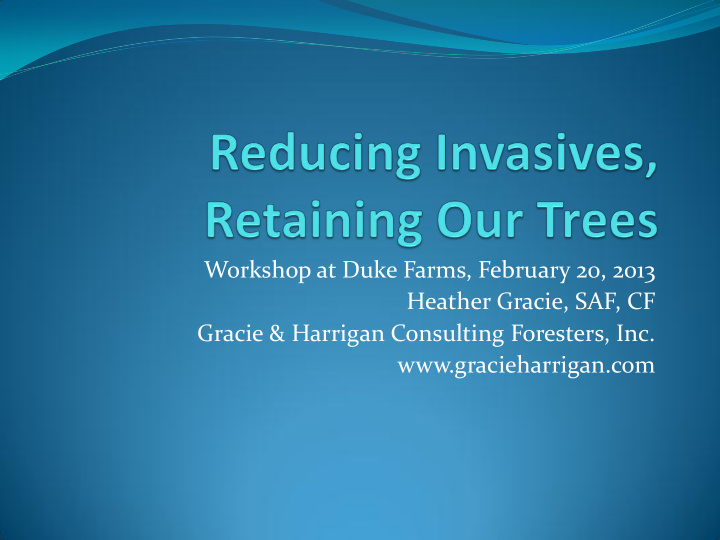



Workshop at Duke Farms, February 20, 2013 Heather Gracie, SAF, CF Gracie & Harrigan Consulting Foresters, Inc. www.gracieharrigan.com
Who are we? Established in the late 1970’s, the firm works with over 825 woodland properties throughout central and northern New Jersey by providing for: Development of Forest Management Plans and Forest Stewardship Plans for private, non-profit, municipal, and State-owned lands Forest Inventory and health assessment Forest Stand Improvement (including non-native invasive plant control) Forest Restoration (including non-native invasive plant control, and tree planting) Wildlife/Riparian Habitat Protection and Restoration Timber Management
Quality field data and analysis leads to… Predicting gypsy moth damage during the winter of 2007.
…meaningful projects with positive results! Client property Camp No-Be-Bo-Sco: 71 ½ acres exotic invasive plant control 5 acres forest stand improvement to improve forest regeneration 1 ¾ acres forest restoration (including deer exclusion fencing and tree planting) All funded through grant money in 2012.
Forest Restoration vs. The Invasive Plant Nightmare Looking back over the last 20- 30 years… Inventory Assessments/Baseline Inventory Non-Native, Invasive Plants: The old guard: Japanese barberry, multiflora rose, Oriental wineberry, garlic mustard. Many introduced as landscape and wildlife plants – most are deer-proof. The new guard: Japanese angelica tree, linden viburnum, Siebold’s viburnum, Oriental photinia, common buckthorn, and glossy buckthorn Japanese stiltgrass – what do you do with it? Deer impact, Herd Reduction and Management
Lesser celandine vs. Virginia bluebells along the North Branch
200+ future linden viburnums prevented
Taking Back the Forest: A giant step backward and (many) small steps forward: Non- native invasive control and restoration projects Site assessment: Plant species present & plant density Common options for control: Mowing, Plant removal (including roots), Herbicides, Prescribed burning, or a combination thereof The medium: Soil type, wetness, and productivity & Light conditions/canopy closure Deer pressure (Quality Deer Management 1:1 Buck-Doe ratio) Identifying Suitable Plants: Native trees and shrubs, proper selection and availability Habitat restoration: Species diversity, age classes, forest structure Protection: Fencing, Deer management, Regular monitoring and maintenance Initial cost and maintenance costs
Mechanized treatment
Selective herbicide treatment
Lotsa volunteers
Moving Ahead: Here Today-Gone Tomorrow? Collaborative efforts: Neighborhood approach – working with the landowner(s), stakeholders Educational outreach: Workshops, Raritan Headwaters Assn., NJ Audubon, NJ Invasive Strike Team, etc. Incentives: NJ Forest Stewardship Act, USDA NRCS cost- share, other grants, sweat-equity/cross-training (calories/hour), tax savings Volunteers: Youth groups, BSA/Girl Scouts, school groups, corporate, “friends” groups, NJ Invasive Strike Team interns Demonstration areas Monitoring and maintenance: success and failures Keeping riparian systems functioning ecologically for people and wildlife!!!
Improving the environment and engaging stakeholders
Recommend
More recommend